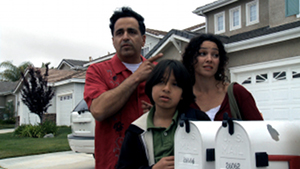Watch video, New York agency, PDFA produce Spanish language PSA
Posted by Elena del Valle on December 6, 2010

A scene from the PSA
Photos, video: Adrenalina
Compared to parents of other racial and ethnic groups Hispanic parents are less likely to talk with their children about the risks of drug and alcohol use. About 88 percent of Latino parents talk with their children while 94 percent of African American and 92 percent of Caucasian parents do, according to a 2008 Partnership Attitude Tracking Study. Among the 35 million families in the country with children ages 9-17, nearly 7 million Hispanic families with children in that age group are considered at risk for abusing drugs and alcohol, according to the Partnership at Drugfree.org.
Although in past years the Partnership at Drugfree.org has teamed up with several ad agencies to target Spanish speaking Americans, this year the non profit organization announced an Habla Con Tus Hijos (Talk with your Kids) ad; the first effort designed to build on the nonprofit organization’s Habla Con Tus Hijos initiative, a Spanish-language website and educational campaign aimed at encouraging parents to have frequent conversations with their kids about the risks of drug and alcohol use. Scroll down to watch the video in Spanish.
The series of 15- and 30-second TV and radio spots in Spanish developed by Adrenalina, a New York ad agency with Hispanic market capabilities, showcases a common neighborhood where everyone points to the neighbor’s kid as the source of local drug problems.
“Talking to your kids about drugs isn’t easy for any parent. The message of this campaign is that today it’s imperative,” said Victor Zeiris, creative director, Adrenalina. “This campaign addresses the problem of denial that’s prevalent in our communities. Two key themes of the creative work are to bring this issue to the forefront and to emphasize the importance of prevention.”

A scene from the PSA
El Hijo del Vecino (Spanish for the neighbor’s child) is meant to illustrate that kids are more exposed to drugs than their parents think and to encourage parents to take an active role protecting their children from drugs. The idea is to help them understand that a problem with the neighbor’s kid can easily become their own problem.
In the ads, the characters ignore what organizers believe is the obvious: that drugs in a community are everybody’s problem emphasizing “Asumir que es el problema de otros es el problema” (“Assuming that it’s somebody else’s problem, is the problem.”)
“We expect that this campaign will strike a chord with Hispanic parents who may not grasp that their kids are just as likely to be exposed to drugs as other people’s kids,” said Caryn Pace, deputy director of creative development, the Partnership at Drugfree.org, by email.
The Partnership began airing Spanish language public service announcements in the late 1990’s in print and broadcast. In 2009, the organization launched online resources for the Spanish-speaking community. Although initially there was a greater response with television messages, in 2010 marketers began to see high CTR’s (click-through-rates) for online ads leading to the continuation of its Hispanic digital program.
In 2009, the Partnership launched Habla Con Tus Hijos, its Spanish-language resource for parents and caregivers. The staff plans for 2011 include increasing the scale of content available to Spanish speakers and aligning with Hispanic partners in the public health and media fields to increase the reach of its message and content to target audiences.
“The Partnership at Drugfree.org reaches out to the Latino community in both Spanish and English. We are cognizant that there are many Hispanic parents whose first language is Spanish and therefore prefer to receive their information in that language. Demographically, there are millions of parents who identify as Hispanic/Latino and are fully acculturated, having been born/raised in the U.S., and prefer to receive health information in English,” said Roselena Martinez, marketing/communications manager, the Partnership at Drugfree.org, when asked about the organization’s outreach efforts to Latinos.
“As a result, we communicate with Hispanic parents in both English and Spanish, and our goal with our Spanish messaging is that it be more sensitive to culturally appropriate issues that predominantly Spanish-speaking parents may face, such as lack of understanding of American slang names for drugs, for example. The Spanish-speaking segment of our target audience(s) has responded positively in the past few years as we have created campaigns that are reaching out to Latino parents with cultural sensitivity, responding to real issues that Hispanic parents are facing that are often unique to them, when compared to other demographic groups.”
Eleven members of Adrenalina worked on the ad which was filmed in suburban Los Angeles. The target audience for this initiative is bicultural and less acculturated Spanish-dominant Hispanic parents 37-years-old, on average, with tweens and teens ages 9-14. The TV spots were directed by Simon Bross, with production work provided by Cortez Brothers, Los Angeles, and edited via Bross. Production work for the radio spots was provided by Mixology Lab, New York. All creative work by Adrenalina and its agency partners was produced pro bono. The Partnership at Drugfree.org is a nonprofit organization with a mission to help parents “prevent, intervene in and find treatment for drug and alcohol use by their children.”









